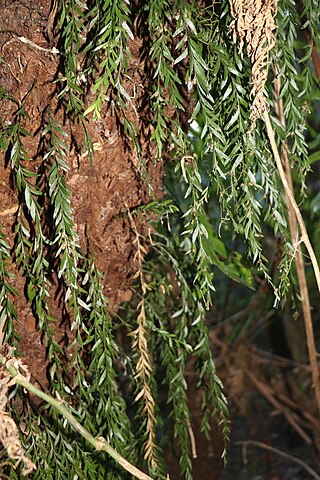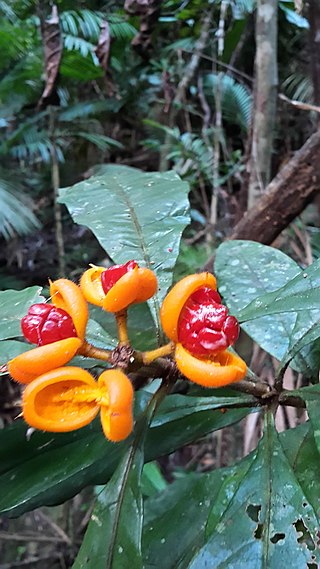
Dicksonia antarctica, the soft tree fern, Tasmanian Tree Fern or man fern, is a species of evergreen tree fern native to eastern Australia, ranging from south-east Queensland, coastal New South Wales and Victoria to Tasmania.

Pittosporum is a genus of about 250 species of flowering plants in the family Pittosporaceae. Plants in the genus Pittosporum are shrubs or trees with leaves arranged alternately along the stems. The flowers are arranged singly or in cymes, with white to yellow petals fused at the base forming a short tube, with stamens that are free from each other. The fruit is a capsule with a single locule that opens to reveal angular seeds.

Pittosporum crassifolium, karo, stiffleaf cheesewood, kaikaro or kihiki is a relatively fast-growing large shrub or small tree with an erect, fastigiate growth habit. It is native to New Zealand.

Hymenosporum is a monotypic genus of trees in the family Pittosporaceae. The sole included species is Hymenosporum flavum, commonly known as native frangipani, found in the rainforests and wet sclerophyll forests of New Guinea, Queensland and New South Wales. Despite its common name, it is not closely related to the frangipani, but is related to the widespread genus Pittosporum.

Pittosporum undulatum is a fast-growing tree in the family Pittosporaceae. It is sometimes also known as sweet pittosporum, native daphne, Australian cheesewood, Victorian box or mock orange.

Frankenia pauciflora, the common sea-heath or southern sea-heath, is an evergreen shrub native to southern Australia. It is part of the Frankenia genus of the Frankeniaceae family.

Pittosporum revolutum commonly known as rough-fruited pittosporum, yellow pittosporum, Brisbane laurel or wild yellow jasmine, is a flowering plant in the family Pittosporaceae and grows in New South Wales, Victoria and Queensland. It is a small shrub with fragrant yellow flowers.

Ozothamnus ferrugineus, commonly known as tree everlasting, is a member of the genus Ozothamnus, of the Asteraceae family – one of the largest families of flowering plants in Australia. Native to the Australian states of New South Wales, Victoria, South Australia, and Tasmania, it forms an erect shrub or small tree between 2 and 3 metres in height.

Leptospermum lanigerum, commonly known as the woolly teatree, is a small tree or medium shrub from the plant family Myrtaceae. Its common name derives from the conspicuously hairy capsules produced as fruit, along with the fine, silky hairs present on branches and leaves. L. lanigerum is widespread in many habitats, particularly in waterlogged areas such as moist, sandy coastal heaths, on river banks, riparian scrub, woodlands and on the fringe of montane grasslands. This species is endemic to Australia, with native populations occurring in New South Wales, South Australia, Tasmania and Victoria.

Pittosporum multiflorum, known as the orange thorn, is a shrub growing in eastern Australia. The dense foliage provides a habitat for small birds and animals. It grows on shales or volcanic soils, from Eden, New South Wales north to Queensland, usually in or near rainforest areas.

Pittosporum tobira is a species of sweet-smelling flowering plant in the pittosporum family Pittosporaceae known by several common names, including Australian laurel, Japanese pittosporum, mock orange and Japanese cheesewood. It is native to Japan, China, Taiwan, and Korea, but it is used throughout the world as an ornamental plant in landscaping and as cut foliage.

Polystichum proliferum, commonly known as mother shield fern is an Australian endemic fern. The genus name Polystichum is derived from Greek poly - many, and stichos - rows referring to the many rows of sori. The species name is derived from Latin, Proli – offspring and fer - bearing referring to the proliferous buds, a prominent feature of the species.

Pittosporum angustifolium, commonly known as butterbush, weeping pittosporum, berrigan, native willow, native apricot, western pittosporum, apricot tree, bitter bush, cattle bush or poison berry tree, is a weeping shrub or tree that is endemic to mostly inland, continental Australia. It has oblong, linear or narrowly elliptic leaves, fragrant yellow to cream-coloured flowers arranged in leaf axils or on the ends of branches, and oval to spherical, yellowish capsules with dark or orange-red seeds.
Tasmania is home to 'Australia’s largest cool temperate rainforests. Most of Tasmania’s rainforests occur in the North-West and throughout the North East highlands. Cool temperate rainforests typically have a heavy rainfall, cool climate, favor high altitudes and have a limited availability of light.

Tmesipteris obliqua, more commonly known as the long fork-fern or common fork-fern, is a weeping, epiphytic fern ally with narrow unbranched leafy stems. T. obliqua is a member of the genus Tmesipteris, commonly known as hanging fork-ferns. Tmesipteris is one of two genera in the order Psilotales, the other genus being Psilotum. T. obliqua is endemic to eastern Australia.

Pittosporum cornifolium, known as tāwhiri karo in Māori, is a species of plant in the Pittosporaceae family. It is an epiphytic plant endemic to the North Island and the Marlborough Sounds of the South Island, New Zealand. In the wild it is considered rare and threatened, although it occurs more frequently on offshore islands in the north-east, along with P. kirkii, the only other epiphytic member of the genus. Also grows well as a ground plant and is a popular garden ornamental with two recognised cultivars.

Pittosporum ferrugineum, commonly known as the rusty pittosporum or rusty-leaved pittosporum, is an evergreen plant in the family Pittosporaceae native to Malesia, Papuasia, the Northern Territory and Queensland.
Gonocarpus humilis, commonly known as shade raspwort, is a small herb in the genus Gonocarpus of the family Haloragaceae. Shade raspwort is common along the eastern coast of Australia, and grows in moist and shaded locations. The leaves have a rough and scabrous surface, giving the plant the common name raspwort.

Pittosporum rubiginosum, commonly known as hairy red pittosporum, is an evergreen shrub in the family Pittosporaceae which is endemic to northeastern Queensland, Australia. It was first described in 1840.




























